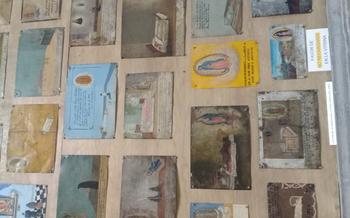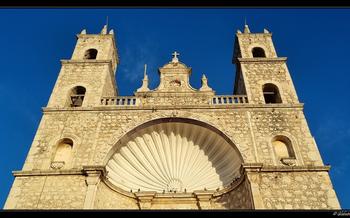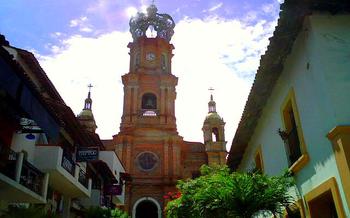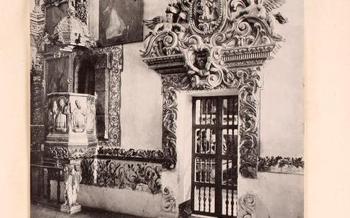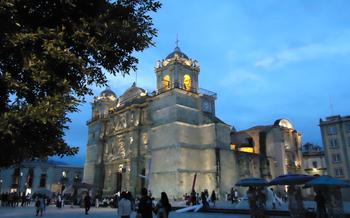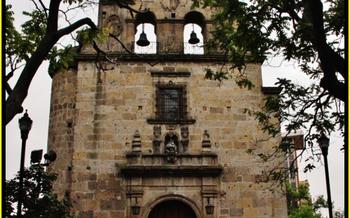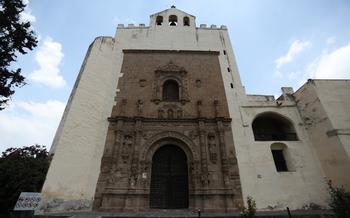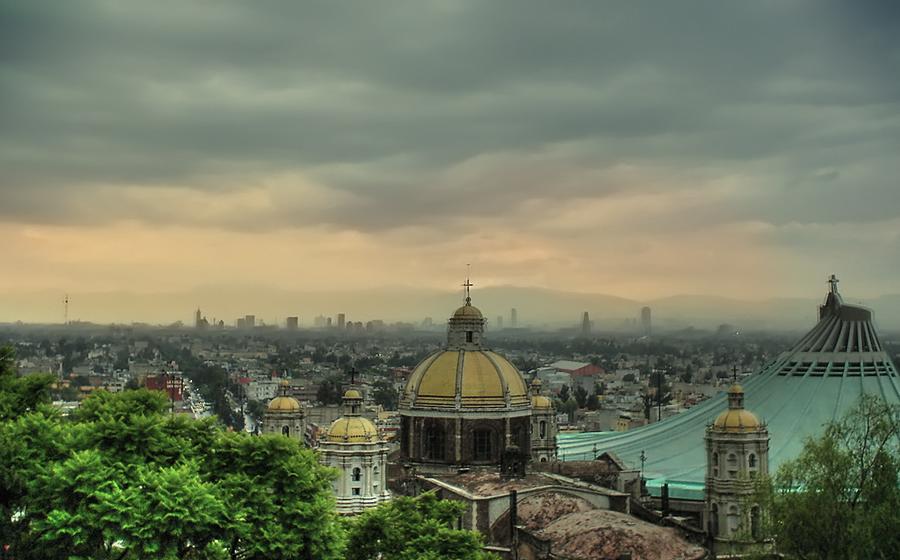
Basilica of Our Lady of Guadalupe
- The Basilica of Our Lady of Guadalupe: A Spiritual Haven
- A Journey of Faith: The Pilgrimage to the Basilica
- The Image of Our Lady of Guadalupe: A Symbol of Hope
- Unveiling the History: The Old Basilica
- The Miraculous Well: A Source of Healing
- The Tepeyac Hill: A Place of Revelation
- Pilgrimage Season: A Time of Celebration
- The Juan Diego Museum: Unveiling the Saint's Life
- The Museum of the Basilica: A Treasure Trove of Art and History
- The Chapel of the Pocito: A Place of Quiet Reflection
- The Atrium: A Gathering Place for Pilgrims
- The Rosary Basilica: A Modern Architectural Marvel
- The Crypt: A Sacred Space for Repose
- Insider Tip: Unveiling Hidden Gems
The Basilica of Our Lady of Guadalupe: A Spiritual Haven
The Basilica of Our Lady of Guadalupe, nestled in the heart of Mexico City, stands as a beacon of faith and spirituality, attracting millions of pilgrims and visitors each year. Its history is deeply intertwined with the miraculous appearance of the Virgin Mary to the humble peasant Juan Diego in 1531, an event that transformed the site into a sacred destination for Catholics worldwide. The basilica, completed in 1976, is an architectural marvel, showcasing a blend of modern and colonial styles. Its impressive dome, adorned with intricate mosaics, dominates the skyline, symbolizing the spiritual significance of this holy place.
-
Religious and cultural importance: The basilica is not only a place of worship but also a symbol of Mexican identity and cultural heritage. The image of Our Lady of Guadalupe, enshrined within the basilica, holds a special place in the hearts of Mexicans, representing hope, unity, and protection. The basilica serves as a pilgrimage site for Catholics from all over the world, who flock to pay homage to the Virgin Mary and seek her blessings.
-
Tips for planning your visit: To fully immerse yourself in the spiritual atmosphere of the basilica, plan your visit carefully. Choose a weekday to avoid the crowds, allowing you to explore the basilica at your own pace. Dress respectfully, covering your shoulders and knees, as a sign of reverence for the sacred space. Guided tours are available in various languages, providing insightful information about the history, architecture, and religious significance of the basilica.
A Journey of Faith: The Pilgrimage to the Basilica
The pilgrimage to the Basilica of Our Lady of Guadalupe holds immense significance for Catholics worldwide. It's a testament to the deep devotion and faith they have in the Virgin Mary. Pilgrims from all walks of life embark on this spiritual journey, seeking blessings, expressing gratitude, and strengthening their connection with the divine.
Before embarking on the pilgrimage, many devotees engage in spiritual preparation, such as fasting, prayer, and confession. They often travel in groups, forming a sense of community and support. As they approach the basilica, a palpable sense of anticipation and excitement fills the air.
During the pilgrimage, pilgrims participate in various religious rituals and traditions. They attend mass, recite prayers, light candles, and offer flowers at the altar. The atmosphere is charged with emotion and devotion as pilgrims pour out their hearts and seek divine intervention.
Practical Tips for Pilgrims:
- Plan your pilgrimage in advance, considering factors like travel arrangements, accommodation, and the duration of your stay.
- Ensure you have comfortable footwear, as you'll likely be walking a lot.
- Bring a hat, sunscreen, and water to protect yourself from the sun and stay hydrated.
- Respect the sanctity of the basilica and dress modestly.
- Be prepared for crowds, especially during peak pilgrimage seasons.
- Take your time to explore the basilica and its surroundings, allowing yourself to fully immerse in the spiritual atmosphere.
The Image of Our Lady of Guadalupe: A Symbol of Hope
The Miraculous Appearance to Juan Diego: The image of Our Lady of Guadalupe holds immense significance in the hearts of Catholics worldwide due to its miraculous appearance to Juan Diego, a humble indigenous man, on Tepeyac Hill in 153According to tradition, the Virgin Mary appeared to Juan Diego, requesting that a church be built on the site of her apparition. She left an imprint of her image on his cloak, which became a powerful symbol of faith and a testament to the Virgin's love for her people.
Cultural and Religious Significance: The image of Our Lady of Guadalupe quickly became a symbol of hope and unity for the indigenous population of Mexico, who were struggling under Spanish rule. The Virgin Mary, depicted as a mestiza woman with dark skin and indigenous features, resonated deeply with the native people, who saw her as a symbol of their own identity and a source of comfort in times of oppression.
Artistic Representations and Symbolism: The image of Our Lady of Guadalupe has been widely reproduced and reinterpreted in various forms of art, including paintings, sculptures, and textiles. Each representation carries unique artistic and symbolic elements, reflecting the diverse cultural and religious interpretations of the Virgin Mary. The image often incorporates symbols of indigenous culture, such as the crescent moon and stars, representing the Aztec goddess Tonantzin, and the four-petaled flower, symbolizing the sun.
Personal Stories and Testimonies: Countless personal stories and testimonies attest to the miraculous powers associated with the image of Our Lady of Guadalupe. Devotees from all walks of life have reported healings, answered prayers, and spiritual transformations after encountering the image. The Virgin Mary's compassionate gaze and loving presence continue to inspire and bring comfort to millions of believers around the world.
Unveiling the History: The Old Basilica
Standing in the shadow of its grand successor, the Old Basilica of Our Lady of Guadalupe holds a rich history and architectural significance. Built in the late 16th century, the old basilica served as the main sanctuary for centuries, attracting millions of pilgrims seeking the blessings of the Virgin Mary. Its unique design, featuring intricate carvings, vaulted ceilings, and a serene atmosphere, reflects the architectural styles of its time. Despite being replaced by the new basilica, the old basilica remains a cherished part of the complex, serving as a testament to the devotion and artistry of its creators.
Visitors to the old basilica can admire its well-preserved facade, adorned with sculptures depicting scenes from the life of the Virgin Mary. The interior, though smaller and less elaborate compared to the new basilica, exudes a sense of intimacy and reverence. The altar, with its gleaming gold accents and intricate detailing, draws the eye and invites contemplation.
Comparing the old and new basilicas offers a fascinating glimpse into the evolution of architectural styles and the changing needs of the growing pilgrimage site. While the old basilica represents the humble beginnings of the shrine, the new basilica showcases the grandeur and opulence that came with its increasing popularity. Together, these two structures tell the story of a sacred site that has stood the test of time, adapting and evolving to accommodate the needs of countless pilgrims seeking solace and spiritual fulfillment.
The Miraculous Well: A Source of Healing
Within the sprawling complex of the Basilica of Our Lady of Guadalupe, a hidden gem awaits discovery: the miraculous well. Located near the old basilica, this sacred site holds a profound significance for pilgrims and visitors alike. According to legend, the well sprang forth miraculously at the feet of Juan Diego, the humble indigenous man to whom Our Lady of Guadalupe appeared.
Stories of healing and miracles associated with the well water have been passed down through generations. Devotees believe that the water possesses miraculous properties that can cure physical ailments and bring spiritual solace. Many pilgrims make a special pilgrimage to the well, seeking blessings and healing for themselves or their loved ones.
Rituals and traditions surround the miraculous well. Visitors often drink the water directly from the well or collect it in bottles to take home. Some light candles and offer prayers, seeking divine intervention and expressing their gratitude for the blessings received.
For those seeking a deeper spiritual experience, the miraculous well offers a tranquil oasis amidst the bustling complex. Visitors can sit by the well, reflect on their faith, and connect with the divine. The peaceful atmosphere and the belief in the well's healing powers create a profound sense of serenity and devotion.
Practical Information:
- The miraculous well is located near the old basilica within the Basilica of Our Lady of Guadalupe complex.
- Visitors can access the well during the basilica's opening hours.
- There are designated areas for drinking and collecting the well water.
- Pilgrims are encouraged to maintain a respectful and prayerful demeanor while visiting the well.
The Tepeyac Hill: A Place of Revelation
Tepeyac Hill, a sacred site nestled in the heart of Mexico City, holds immense religious and cultural significance. Its history is intertwined with the miraculous apparitions of Our Lady of Guadalupe to Saint Juan Diego in 153According to tradition, the Virgin Mary appeared to Juan Diego on the hill, leaving her image imprinted on his tilma, a traditional cloak. This event marked the beginning of the Guadalupe devotion, which has since become a cornerstone of Mexican Catholicism.
The hilltop offers a breathtaking panoramic view of the city, with the Basilica of Our Lady of Guadalupe standing as a beacon of faith in the foreground. Visitors can climb the hill on foot or take the escalators provided for easy access. Along the way, they can immerse themselves in the spiritual atmosphere, passing by Stations of the Cross and other religious monuments that recount the story of the apparitions.
Tepeyac Hill is not just a historical site but also a living testament to the enduring faith of the Mexican people. Throughout the year, pilgrims from all corners of the country and beyond flock to the hill to pay homage to Our Lady of Guadalupe and seek her blessings. The hilltop plaza serves as a gathering place for prayer, reflection, and celebration, where pilgrims can light candles, leave offerings, and participate in religious ceremonies.
For those seeking a deeper connection with the Guadalupe tradition, guided tours are available to provide insights into the history, symbolism, and cultural significance of the site. Visitors can also explore the nearby Capuchin monastery, which houses a museum dedicated to the life of Saint Juan Diego and the apparitions.
Pilgrimage Season: A Time of Celebration
The pilgrimage season to the Basilica of Our Lady of Guadalupe is a significant event that draws millions of devoted pilgrims from all over the world. Typically held from December 12th to January 12th, this period is marked by a palpable sense of festivity and spiritual fervor.
During this time, the basilica and its surroundings transform into a vibrant hub of activity. The air is filled with the sounds of music, prayers, and the chatter of pilgrims sharing stories and experiences. The atmosphere is one of camaraderie and shared devotion, as people from diverse backgrounds come together to celebrate their faith and seek blessings from the Virgin Mary.
Special events, masses, and processions are held throughout the pilgrimage season, adding to the festive spirit. These events offer pilgrims opportunities to participate in communal rituals and deepen their connection to the basilica and its history.
For those planning a visit during the pilgrimage season, it is advisable to book accommodations and transportation in advance, as the influx of pilgrims can make it challenging to find available options. Additionally, be prepared for crowds and long lines, especially during peak periods.
The pilgrimage season is a truly special time to experience the Basilica of Our Lady of Guadalupe. It is a celebration of faith, tradition, and the enduring devotion to the Virgin Mary that has made this basilica one of the most important pilgrimage sites in the world.
The Juan Diego Museum: Unveiling the Saint's Life
Nestled within the sacred grounds of the Basilica of Our Lady of Guadalupe, the Juan Diego Museum stands as a testament to the life and legacy of Saint Juan Diego, the humble indigenous man who witnessed the miraculous apparitions of the Virgin Mary.
Inside the museum, an array of interactive exhibits and captivating displays narrate the extraordinary journey of Juan Diego, from his humble beginnings to his pivotal role in the Guadalupe story. Historical artifacts, including the tilma or cloak on which the Virgin's image was miraculously imprinted, offer tangible evidence of his profound encounter.
Through immersive storytelling and multimedia presentations, visitors gain insights into the canonization process that elevated Juan Diego to sainthood, recognizing his unwavering faith and the profound impact of his experience. The museum serves as a sanctuary for reflection, allowing pilgrims and visitors alike to connect with the spirit of this revered figure and deepen their understanding of the Guadalupe narrative.
The Museum of the Basilica: A Treasure Trove of Art and History
Enrich your visit to the Basilica of Our Lady of Guadalupe by exploring the on-site museum, a treasure trove of religious art and artifacts that narrate the basilica's captivating history. Admire an extensive collection of paintings, sculptures, and textiles, each meticulously preserved and showcasing the artistic mastery of renowned Mexican and international artists.
Among the highlights of the museum are the intricate paintings depicting scenes from the life of Our Lady of Guadalupe and the apparition to Juan Diego. These masterpieces, rendered with vibrant colors and meticulous detail, transport visitors back in time to witness these pivotal moments in the basilica's history.
Discover the historical significance of the artifacts on display, including vestments worn by popes and other high-ranking religious figures. These relics offer a tangible connection to the basilica's rich past and its role as a center of Catholic pilgrimage.
To fully appreciate the depth and breadth of the museum's collection, consider engaging the services of a knowledgeable guide. These experts can provide insightful commentary and historical context, enhancing your understanding of the artworks and artifacts.
Practical Tip: Allocate ample time for your visit to the museum, as the sheer volume and significance of the collection warrant a thorough exploration. Plan to spend at least an hour or two immersing yourself in the artistic and historical treasures that await you.
The Chapel of the Pocito: A Place of Quiet Reflection
Nestled within the expansive Basilica of Our Lady of Guadalupe complex, the Chapel of the Pocito (the Well), stands as a sanctuary of tranquility and spiritual reflection. This intimate chapel holds a unique place in the hearts of pilgrims and visitors alike, inviting them to connect with the miraculous events that unfolded on this very ground.
The chapel's history is intertwined with the story of Juan Diego, the humble indigenous man who witnessed the apparition of Our Lady of Guadalupe. According to legend, the Virgin Mary instructed Juan Diego to dig a well on this spot, and as he did, a miraculous spring gushed forth, providing water for the thirsty pilgrims who flocked to the site.
Today, the Chapel of the Pocito stands as a testament to the miraculous events that transpired here. Its simple yet elegant architecture exudes an aura of serenity, inviting visitors to pause and reflect on the profound significance of this place. The chapel's interior is adorned with beautiful murals depicting scenes from the apparition and the life of Saint Juan Diego, further enhancing its spiritual atmosphere.
Pilgrims and visitors alike are drawn to the Chapel of the Pocito for its tranquility and the opportunity to connect with the miraculous events that occurred here. Many come to pray, light candles, or simply sit in quiet contemplation, seeking solace and spiritual renewal. The chapel's peaceful ambiance provides a respite from the bustling crowds of the basilica, allowing for a deeper and more personal connection with the divine.
The Atrium: A Gathering Place for Pilgrims
At the heart of the Basilica of Our Lady of Guadalupe lies the atrium, a vast and awe-inspiring space that serves as a gathering place for pilgrims and visitors alike. This expansive courtyard is adorned with intricate tilework, ornate fountains, and lush gardens, creating a breathtaking and serene atmosphere. As you step into the atrium, you'll be struck by its sheer size and the harmonious blend of architectural styles that define this sacred space.
The atrium is not just a physical space but also a symbol of the basilica's spiritual significance. It represents the welcoming embrace of the Virgin of Guadalupe, inviting pilgrims from all walks of life to come together in unity and faith. Throughout the year, the atrium hosts a variety of cultural and religious events, including processions, concerts, and traditional dances, further enriching the spiritual experience of visitors.
As you wander through the atrium, take a moment to admire the intricate details of its architecture. The graceful arches, elegant columns, and vibrant murals depict scenes from the life of the Virgin Mary and the history of the basilica, adding depth and meaning to the space. The central fountain, with its cascading waters, symbolizes the purity and grace of Our Lady of Guadalupe, inviting visitors to pause and reflect on her divine presence.
Whether you're seeking a quiet moment of contemplation or looking to immerse yourself in the vibrant energy of the pilgrimage, the atrium of the Basilica of Our Lady of Guadalupe is a place where you can connect with your faith and find solace amidst the bustling crowds.
The Rosary Basilica: A Modern Architectural Marvel
The Rosary Basilica, a striking architectural masterpiece within the Basilica of Our Lady of Guadalupe complex, stands as a testament to the fusion of modern design and religious devotion. Its unique and captivating form, resembling an open book, symbolizes the unfolding story of faith and revelation.
Completed in 1976 and designed by renowned architect Pedro Ramírez Vázquez, the Rosary Basilica is a remarkable feat of engineering and artistry. Its sweeping concrete structure, adorned with intricate stained glass windows, creates an ethereal ambiance that invites contemplation and prayer. The basilica's unconventional design, breaking away from traditional basilica forms, reflects the forward-thinking spirit of the 20th century while honoring the sacred traditions of the Catholic Church.
Inside, the basilica's vast and luminous interior offers a serene and awe-inspiring space for worship. The play of light through the stained glass windows casts a kaleidoscope of colors, illuminating the intricate murals and sculptures that adorn the walls. The altar, positioned at the focal point of the basilica, serves as a reminder of the central role of the Eucharist in Catholic devotion.
The Rosary Basilica, a true architectural gem, stands as a symbol of faith, innovation, and the enduring legacy of the Basilica of Our Lady of Guadalupe. Its modern design, harmonizing with the basilica's rich history, creates a unique and unforgettable experience for pilgrims and visitors alike, inviting them to delve deeper into the spiritual journey that unfolds within this sacred space.
The Crypt: A Sacred Space for Repose
Beneath the grandeur of the Basilica of Our Lady of Guadalupe lies the crypt, a sacred space imbued with a profound sense of serenity and reverence. This subterranean chamber serves as the final resting place for esteemed religious figures, including former archbishops and priests who dedicated their lives to serving the basilica and its faithful.
The crypt's architectural features exude an aura of solemnity, with its vaulted ceilings, intricate stone carvings, and stained glass windows casting a soft, ethereal glow upon the surroundings. The hushed whispers and footsteps of visitors echo through the chamber, creating a palpable atmosphere of respect and remembrance.
For those seeking a moment of quiet reflection or a deeper connection with the spiritual legacy of the basilica, the crypt offers a sanctuary of peace and tranquility. Here, visitors can pay their respects to the departed and contemplate the eternal cycle of life and faith.
Tips for visiting the crypt:
-
Dress respectfully: Out of respect for the sacred nature of the crypt, visitors are encouraged to dress modestly and refrain from wearing shorts, tank tops, or revealing clothing.
-
Be mindful of noise: The crypt is a place of quiet contemplation, so visitors should avoid talking loudly or disturbing the peaceful atmosphere.
-
Take your time: Allow yourself ample time to explore the crypt and appreciate the intricate details of its architecture and artwork.
-
Reflect on the legacy: As you wander through the crypt, take a moment to reflect on the lives of the individuals who have been laid to rest here. Consider their contributions to the basilica and the impact they have had on the spiritual lives of countless pilgrims.
Insider Tip: Unveiling Hidden Gems
Beyond the main attractions, the Basilica of Our Lady of Guadalupe complex holds secret spots that offer unique perspectives and tranquil moments. Explore the serene gardens, tucked away from the bustling crowds, where you can find solace and reflection amidst nature's beauty. Discover the hidden chapels, each with its distinct charm and history, where you can offer a quiet prayer or simply soak in the spiritual atmosphere.
Venture off the beaten path to uncover local culinary gems near the basilica. Indulge in traditional Mexican dishes at family-run restaurants that have been serving pilgrims and locals for generations. Savor the flavors of authentic Mexican cuisine and immerse yourself in the vibrant culinary culture of the region.
For a truly immersive experience, seek recommendations from locals. Ask about their favorite spots for traditional handicrafts, unique souvenirs, or local markets where you can find treasures that capture the essence of Mexico's rich cultural heritage. Embrace the opportunity to connect with the local community and learn about their traditions, ensuring a truly memorable and authentic visit to the Basilica of Our Lady of Guadalupe.

